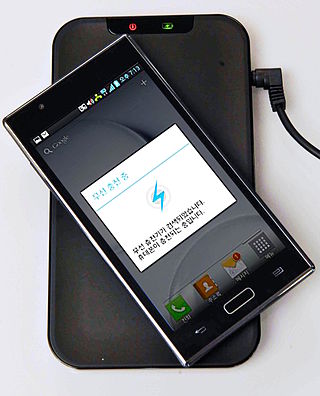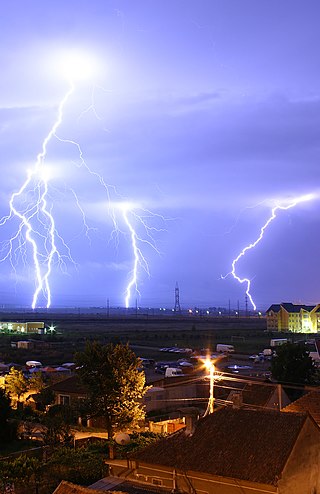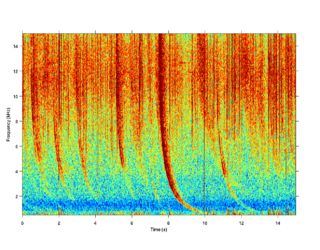
The ionosphere is the ionized part of the upper atmosphere of Earth, from about 48 km (30 mi) to 965 km (600 mi) above sea level, a region that includes the thermosphere and parts of the mesosphere and exosphere. The ionosphere is ionized by solar radiation. It plays an important role in atmospheric electricity and forms the inner edge of the magnetosphere. It has practical importance because, among other functions, it influences radio propagation to distant places on Earth. Travel through this layer also impacts GPS signals, resulting in effects such as deflection in their path and delay in the arrival of the signal.

The stratosphere is the second-lowest layer of the atmosphere of Earth, located above the troposphere and below the mesosphere. The stratosphere is composed of stratified temperature zones, with the warmer layers of air located higher and the cooler layers lower. The increase of temperature with altitude is a result of the absorption of the Sun's ultraviolet (UV) radiation by the ozone layer, where ozone is exothermically photolyzed into oxygen in a cyclical fashion. This temperature inversion is in contrast to the troposphere, where temperature decreases with altitude, and between the troposphere and stratosphere is the tropopause border that demarcates the beginning of the temperature inversion.

An aurora , also commonly known as the northern lights or southern lights, is a natural light display in Earth's sky, predominantly seen in high-latitude regions. Auroras display dynamic patterns of brilliant lights that appear as curtains, rays, spirals, or dynamic flickers covering the entire sky.

Lightning is a natural phenomenon, more specifically an atmospheric electrical phenomenon. It consists of electrostatic discharges occurring through the atmosphere between two electrically charged regions, either both existing within the atmosphere or one within the atmosphere and one on the ground, with these regions then becoming partially or wholly electrically neutralized.

The Schumann resonances (SR) are a set of spectral peaks in the extremely low frequency portion of the Earth's electromagnetic field spectrum. Schumann resonances are global electromagnetic resonances, generated and excited by lightning discharges in the cavity formed by the Earth's surface and the ionosphere.

Wireless power transfer is the transmission of electrical energy without wires as a physical link. In a wireless power transmission system, an electrically powered transmitter device generates a time-varying electromagnetic field that transmits power across space to a receiver device; the receiver device extracts power from the field and supplies it to an electrical load. The technology of wireless power transmission can eliminate the use of the wires and batteries, thereby increasing the mobility, convenience, and safety of an electronic device for all users. Wireless power transfer is useful to power electrical devices where interconnecting wires are inconvenient, hazardous, or are not possible.

A terrestrial gamma-ray flash (TGF), also known as dark lightning, is a burst of gamma rays produced in Earth's atmosphere. TGFs have been recorded to last 0.2 to 3.5 milliseconds, and have energies of up to 20 million electronvolts. It is speculated that TGFs are caused by intense electric fields produced above or inside thunderstorms. Scientists have also detected energetic positrons and electrons produced by terrestrial gamma-ray flashes.

Atmospheric electricity describes the electrical charges in the Earth's atmosphere. The movement of charge between the Earth's surface, the atmosphere, and the ionosphere is known as the global atmospheric electrical circuit. Atmospheric electricity is an interdisciplinary topic with a long history, involving concepts from electrostatics, atmospheric physics, meteorology and Earth science.

In electromagnetism, an electric discharge is the release and transmission of electricity in an applied electric field through a medium such as a gas.

A lightning detector is a device that detects lightning produced by thunderstorms. There are three primary types of detectors: ground-based systems using multiple antennas, mobile systems using a direction and a sense antenna in the same location, and space-based systems. The first such device was invented in 1894 by Alexander Stepanovich Popov. It was also the first radio receiver in the world.
In electromagnetism, a leader is a hot, highly conductive channel of plasma that plays a critical part during dielectric breakdown within a long electric spark.

A global atmospheric electrical circuit is the continuous movement of atmospheric charge carriers, such as ions, between an upper conductive layer and surface. The global circuit concept is closely related to atmospheric electricity, but not all atmospheres necessarily have a global electric circuit. The basic concept of a global circuit is that through the balance of thunderstorms and fair weather, the atmosphere is subject to a continual and substantial electrical current.

Upper-atmospheric lightning and ionospheric lightning are terms sometimes used by researchers to refer to a family of short-lived electrical-breakdown phenomena that occur well above the altitudes of normal lightning and storm clouds. Upper-atmospheric lightning is believed to be electrically induced forms of luminous plasma. The preferred usage is transient luminous event (TLE), because the various types of electrical-discharge phenomena in the upper atmosphere lack several characteristics of the more familiar tropospheric lightning.

A radio atmospheric signal or sferic is a broadband electromagnetic impulse that occurs as a result of natural atmospheric lightning discharges. Sferics may propagate from their lightning source without major attenuation in the Earth–ionosphere waveguide, and can be received thousands of kilometres from their source. On a time-domain plot, a sferic may appear as a single high-amplitude spike in the time-domain data. On a spectrogram, a sferic appears as a vertical stripe that may extend from a few kHz to several tens of kHz, depending on atmospheric conditions.

Sprites or red sprites are large-scale electric discharges that occur in the mesosphere, high above thunderstorm clouds, or cumulonimbus, giving rise to a varied range of visual shapes flickering in the night sky. They are usually triggered by the discharges of positive lightning between an underlying thundercloud and the ground.

Volcanic lightning is an electrical discharge caused by a volcanic eruption rather than from an ordinary thunderstorm. Volcanic lightning arises from colliding, fragmenting particles of volcanic ash, which generate static electricity within the volcanic plume, leading to the name dirty thunderstorm. Moist convection currents and ice formation also drive the eruption plume dynamics and can trigger volcanic lightning. Unlike ordinary thunderstorms, volcanic lightning can also occur when there are no ice crystals in the ash cloud.

A relativistic runaway electron avalanche (RREA) is an avalanche growth of a population of relativistic electrons driven through a material by an electric field. RREA has been hypothesized to be related to lightning initiation, terrestrial gamma-ray flashes, sprite lightning, and spark development. RREA is unique as it can occur at electric fields an order of magnitude lower than the dielectric strength of the material.

A magneto is an electrical generator that uses permanent magnets to produce periodic pulses of alternating current. Unlike a dynamo, a magneto does not contain a commutator to produce direct current. It is categorized as a form of alternator, although it is usually considered distinct from most other alternators, which use field coils rather than permanent magnets.
An electromagnetic pulse (EMP), also referred to as a transient electromagnetic disturbance (TED), is a brief burst of electromagnetic energy. The origin of an EMP can be natural or artificial, and can occur as an electromagnetic field, as an electric field, as a magnetic field, or as a conducted electric current. The electromagnetic interference caused by an EMP can disrupt communications and damage electronic equipment. An EMP such as a lightning strike can physically damage objects such as buildings and aircraft. The management of EMP effects is a branch of electromagnetic compatibility (EMC) engineering.
Everly John "Jack" Workman was an American atmospheric physicist, known for the Workman-Reynolds effect, discovered in 1950 by him and his colleague Stephen E. Reynolds, State Engineer of New Mexico from 1955 to 1990.















